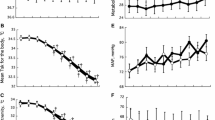Abstract
Skin sympathetic vasomotor control can be examined in the extremities by the skin vasomotor test. In this test the change in skin blood flow and skin temperature in the hand and foot in response to a cold stimulus is utilized as an index of distal sympathetic nerve fibre integrity. This is of importance in conditions such as diabetes mellitus as peripheral autonomic neuropathy is associated with orthostatic hypotension and diabetic foot complications. The validity and reproducibility of the test as a marker of distal sympathetic nerve function has been studied. The test was performed in nine healthy control subjects and in nine subjects (undergoing minor surgery) after a sympathetic nerve conduction block (L2–L3) was achieved in the lower extremities by spinal analgesia. Changes in skin temperature (p < 0.001) and skin blood flow (p < 0.005) in responses to cooling were significantly larger in the control group than in the group with spinal analgesia. Repeated skin temperature measurements on 42 occasions (test—retest period of 4 weeks) in eight healthy and 34 diabetic subjects indicated a reliability coefficient of 80%. We conclude, therefore, that the skin vasomotor test provides a valid and reproducible quantitative assessment of skin sympathetic nerve function in upper and lower extremities.
Similar content being viewed by others
References
Watkins PJ, Edmonds ME. Sympathetic nerve failure in diabetes.Diabetologia 1983;25: 73–77.
Parkhouse N, Le Quesne PM. Impaired neorogenic vascular response in patients with diabetes and neuropathic foot lesions.N Engl J Med 1988;318: 1306–1309.
Ewing DJ. Analysis of heart rate variability and other non-invasive tests with special reference to diabetic neuropathy. In: Bannister R, Mathias CJ, eds.Autonomic failure. A textbook of clinical disorders of the autonomic nervous system. Oxford: Oxford University Press, 1992: 312–333.
Fagius J, Wallin BG. Sympathetic reflex latencies and conduction velocities in normal man.J Neurol Sci 1980;47: 433–448.
Fagius J, Wallin BG. Sympathetic reflex latencies and conduction velocities in patients with polyneuropathy.J Neurol Sci 1980;47: 449–461.
Donk AF, Faes TJC, Broere D, Van der Veen EA, Bertelsmann FW. Quantitation of skin vasomotor control in normal subjects and in diabetic patients with autonomic neuropathy.J Neurol 1990;237: 457–460.
Love TJ. Thermography as an indicator of blood perfusion.Ann N Y Acad Sci 1980;335: 429–437.
Nilsson AL. Blood flow, temperature and heat loss of skin exposed to local radiative and convective cooling.J Invest Dermatol 1987;88: 586–593.
Magnusson D.Test theory. Reading, MA: Addison-Wesley, 1966.
Nunnally JC.Psychometric theory. New York: McGraw-Hill, 1978: 190–255.
Faes TJC, Yff GA, De Weerdt O, Lanting P, Heimans JJ, Bertelsmann FW. Treatment of diabetic autonomic neuropathy with an aldose-reductase inhibitor.J Neurol 1993;240: 156–160.
Skundvist G, Almer LO, Lija B. Respiratory influence of the heart rate in diabetes mellitus.Br Med J 1979;1: 924–925.
Bergström B, Rosberg K, Sundkvist G. Autonomic nerve function test. Reference values in healthy subjects.Clin Physiol 1986;6: 523–528.
Jentink HW.Laser Doppler velocimetry using diode laser. Twente, The Netherlands: Twente University of Technology, 1989.
Suichies HE, Aarnoudse JG, Okken A, Jentink HW, De Mul FMM, Greve J. Forehead skin blood flow in normal neonates during active and quiet sleep, measured with a diode laser Doppler instrument.Acta Paediatr Scan 1987;77: 220–225.
Low PA, Neumann C, Dyck PJ, Fealey RI. Evaluation of skin vasomotor reflexes by using laser doppler velocimetry.Mayo Clin Proc 1983;58: 583–592.
Winer BJ.Statistical principles in experimental designs. New York: McGraw-Hill, 1971: 244–254, 283–296.
Bland M.An introduction to medical statistics. Oxford: Oxford University Press, 1990: 276–278.
Greenfield ADM. The circulation through the skin. In: Hamilton WF, Dow P, eds.Handbook of physiology, Section 2, Circulation (vol. 2). Washington, DC: American Physiological Society, 1963.
Brengelmann G. Temperature regulation. In: Ruch TC, Patton HD, eds.Physiology and biophysics. Philadelphia, PA: Saunders, 1973: 105–135.
Moorhouse JA, Carter SA, Doupe J. Vascular responses in diabetic peripheral neuropathy.Br Med J 1966;1: 883–888.
Allen JA, Finlay RJ, Roddie IC. The effect of local temperature on the response of an extremity to indirect heating in man.Clin Sci 1984;66: 27–32.
Dyck PJ, Kratz KM, Lehman KA,et al. The Rochester Diabetic Neuropathy Study: design, criteria for types of neuropathy, selection bias, and reproducibility of neuropathic tests.Neurology 1991;41: 799–807.
Mathias CJ, Bannister R. Investigation of autonomic disorders. In: Bannister R, Mathias CJ, eds.Autonomic failure. Oxford: Oxford University Press, 1992: 255–290.
Wieling W. Non-invasive continuous recording of heart rate and blood pressure in the evaluation of neurocardiovascular control. In: Bannister R, Mathias CJ, eds.Autonomic failure. A textbook of clinical disorders of the autonomic nervous system. Oxford: Oxford University Press, 1992: 291–311.
Stevens MJ, Edmonds ME, Foster AVM, Douglas SLE, Watkins PJ. Paradoxical blood flow responses in diabetic neuropathy foot: an assessment of the contribution of the vascular denervation and microangiopathy.Diabetic Medicine 1992;9: 49–54.
Deanfield JE, Daggett PR, Harrison MJG. The role of autonomic neuropathy in diabetic foot ulceration.J Neurol Sci 1980;47: 203–210.
Edmonds ME, Nicolaides KH, Watkins PJ. Autonomic neuropathy in diabetic foot ulceration.Diabetic Med 1986;3: 56–59.
Author information
Authors and Affiliations
Rights and permissions
About this article
Cite this article
Faes, T.J.C., Wagemans, M.F.M., Cillekens, J.M. et al. The validity and reproducibility of the skin vasomotor test—studies in normal subjects, after spinal anaesthesia, and in diabetes mellitus. Clinical Autonomic Research 3, 319–324 (1993). https://doi.org/10.1007/BF01827333
Received:
Accepted:
Issue Date:
DOI: https://doi.org/10.1007/BF01827333




